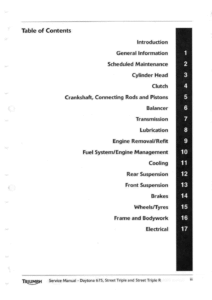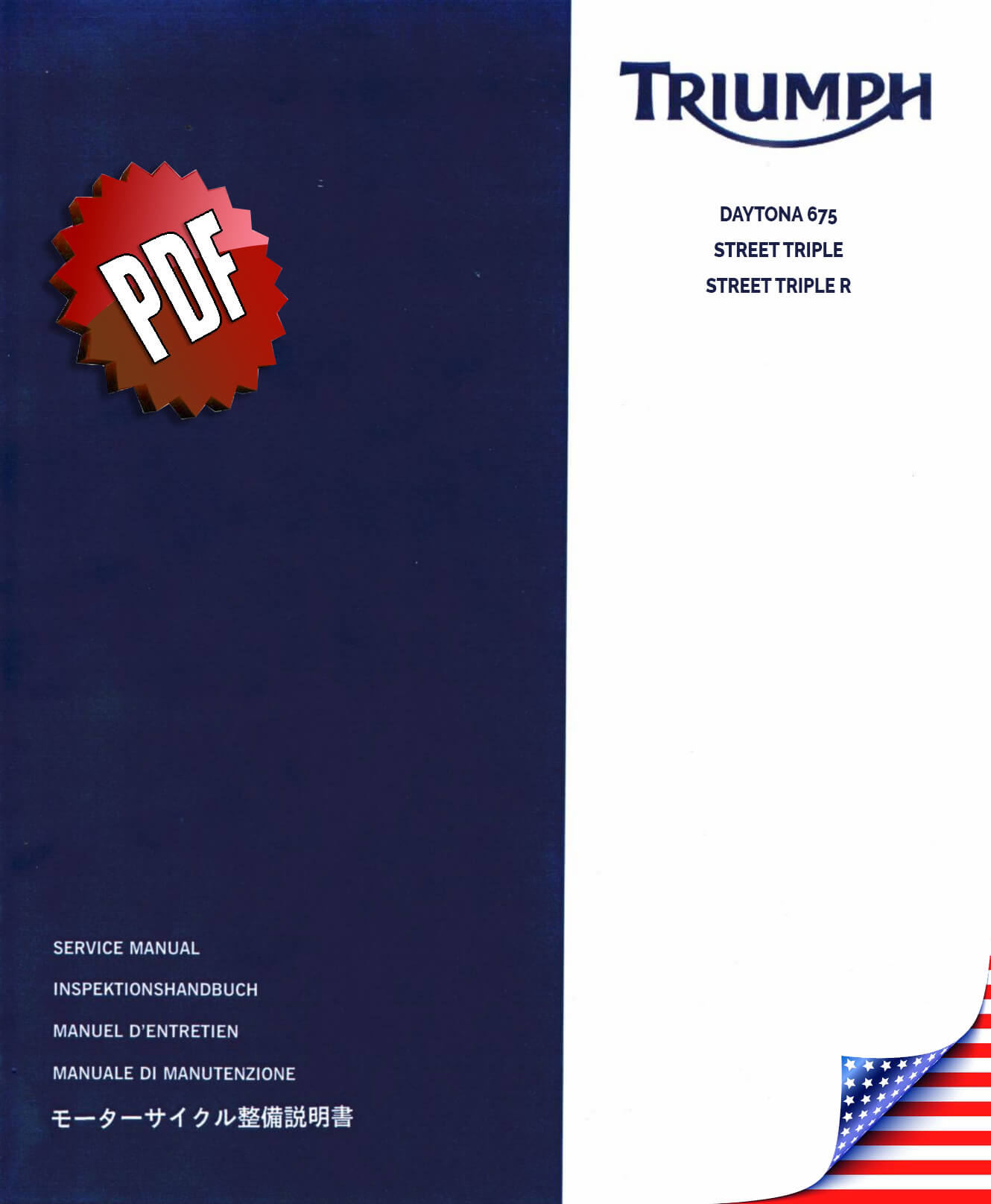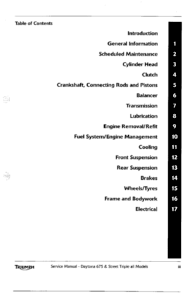Complete PDF version of the Service Manual for the Triumph Daytona 675 / Street Triple. A MUST for every Street Triple owner.
Download: Immediately after payment!
OEM Original factory workshop manual.
Models covered by this manual: 2006-2011
Number of pages: 535 pages
Table of contents:

This PDF repair manual can be downloaded right after the payment process in complete, on the device of your choice.
We do not offer printed manuals, for the following reasons:
- it is more eco-friendly to use a digital version
- your manual never gets dirty or greasy
- you can always choose to print the specific page(s) you need to work on your bike
- you receive your manual immediately after payment
- it is searchable

Triumph Daytona 675 / Street Triple
The Triumph Daytona 675 is a three-cylinder sport bike that was introduced in 2006. It is the smallest of the Triumph triples. Triumph Motorcycles built it to replace their four-cylinder Daytona 650. The 675 proved to be incredibly light, agile, and powerful; with a maximum power output of 128 bhp, it was also quite speedy, and it outperformed the Japanese 600 cc rivals. Triumph discontinued manufacture of the base model Daytona 675 in 2016, citing declining demand for supersport motorcycles and increasingly stringent European emission rules. Triumph produced the higher-spec Triumph Daytona 675R variant until the 2018 model year. Triumph registered a new trademark for the Daytona, fueling speculation of a future version with the new 765 cc engine.
The Triumph Street Triple is a naked or streetfighter motorcycle produced by Triumph Motorcycles that was originally introduced at the end of 2007. The bike is based on the Speed Triple 1050, but it has a retuned inline three cylinder 675 cc engine from the 2006 Daytona 675 sport bike.
675
Following the release of the four-cylinder TT600 in 2000, development of the Triumph Daytona 675 began. Triumph’s first contemporary middleweight sports motorbike, the TT600, failed to compete with Japanese 600 cc supersport bikes. As a result, Triumph chose to produce a bike closer to its historic principles, making the critical technical decision to use a three-cylinder engine rather than a four-cylinder as in the TT600.
Triumph began engineering studies in 2001, shortly after the completion of the comparable three-cylinder-powered Triumph Daytona 955i, to determine weight, engine performance in terms of power and torque. The project advanced to the complete concept phase in March 2002, once the statistics were approved.
The first chassis development was carried out using a chopped Daytona 600 chassis. Triumph shifted the wheelbase, altered the head angle, and altered the tank. This new design outperformed the original Daytona 600, providing a foundation for comparisons with competitors such as the Kawasaki Ninja ZX-6R and Honda CBR600RR. While engine development was still ongoing, computer-aided chassis development proceeded using the data gathered from these testing.
The Daytona 675’s design development continued, yielding a largely black look based on the Daytona 600. This early design, however, was abandoned because outstanding British designs of the 1960s had “a flowing curving shape – no harsh angular aggressive edges.” One of the engineering team members created a concept picture of the 675 as a naked bike. The styling was inspired on this concept picture as well as that of the previous T595 model. Styling was developed in-house, retaining true to the spirit of prior Triumph designs. Market research groups comprised of various classes of sportbike riders selected the latter type of bike, which was developed and accepted for production.
In May 2003, the newly improved engine was tested on a dynamometer for the first time. Final development swiftly followed, merging styling, engine, and chassis into a prototype. Testing on prototypes began in late 2004.
The Daytona 675 was unveiled at the 2005 NEC International Motorcycle and Scooter Show. Bike, situated in the United Kingdom, was granted an exclusive test ride prior to the official introduction, which impressed the magazine’s test rider. It was dubbed “the best British sportsbike ever” and “perhaps one of the greatest sportsbikes of all time” by the magazine.
Street Triple
A number of spy images and speculative design sketches were published in the motorcycling press in 2007, with one publication recording a road test of the finished Street Triple. Later stories discussed leaked design images of the new bike. On March 6, 2007, a report on the final bike’s presentation to dealers was released, along with a spy video of a test ride.
First generation (2007 – 2011)
In 2007, the Triumph Street Triple was introduced to replace the 600 Speed Four. It had the same design as the present Triumph naked versions, which were launched on the Speed Triple in 2005, with high-level double-barrel silencers, dual circular headlamps, and a dashboard unit positioned on top. The Speed Triple has a standard swingarm rather than a single-sided unit, which is the most noticeable change. Parts of the bike are shared with the Triumph Daytona 675, most notably the frame and swingarm. The Daytona 675’s 675cc triple-cylinder engine has been de-tuned to make it more street friendly and acceptable as a daily rider naked, but it is still strong in the category with 79 kW (106 horsepower) At 11,750 rpm.
Because the Daytona 675 engine has three cylinders, Triumph introduced a new naming scheme rather than adding the displacement to the Speed Triple name, resulting in a completely new model in Triumph history.
The Street Triple R, which was introduced in 2008, has the same engine and chassis as the normal model but features fully adjustable suspension both front and rear, which is shared with the Daytona. The altered rear suspension results in a slightly higher seat height and a sharper rake than the original model. The Triumph 675 Daytona’s front brakes are likewise similar, with a fully radial Nissin system, master cylinder, and calipers. It differed from the normal bike in terms of handlebars, seat, and distinct color schemes, which were matte orange and matte grey.
Source: Wikipedia




